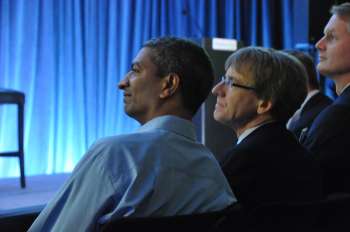Sunnyvale, Calif.-based
Bloom Energy is holding a press event Wednesday morning where the company is expected to unveil further details on its Bloom Box product. In case you're just joining us, these boxes promise to not only bring ample amounts of power in a small amount of space, but to change people's dependency on traditional power grids. All for less than $3,000 a unit.
The event is being held at eBay's San Jose, Calif., headquarters, which has been running a test batch of Bloom Boxes for the past nine months. Former secretary of state and current Bloom Energy board member Colin Powell is slated to speak, along with Bloom Energy founder K.R. Sridhar and venture capitalist John Doerr, who currently sits on President Obama's Economic Recovery Advisory Board. There's also a surprise appearance by what the event planners claim will be a "prominent California government official."
We'll be there snapping photos and bringing you the updates as they happen. If you want a simple reminder, just sign up with your e-mail in the CoverItLive blog below. It'll give you the heads up when we get things going, which should be around 8:30 a.m. PST.
BloomEnergy's live conference today on Feb 24. Source : news.cnet.com
| | Bloom Box press briefing | (02/24/2010) |
10:10 | [Standby] We're changing rooms for a Q&A session with Sridhar and others. Be back shortly. |

English

简体中文

Dansk

Deutsch

Español

Français

Italiano

日本語

Nederlands

Norsk

Português

Русский

Svenska


































No comments:
Post a Comment